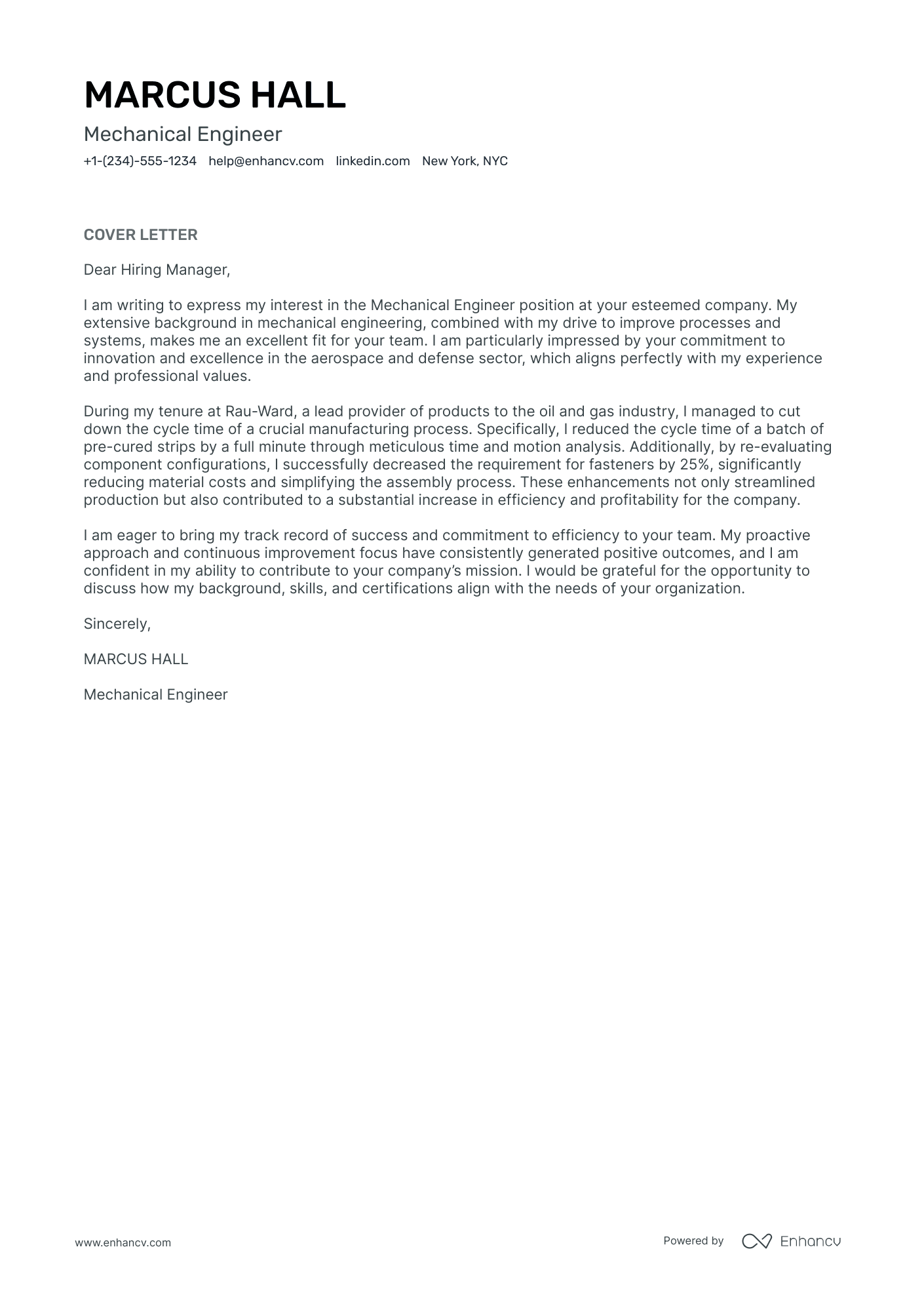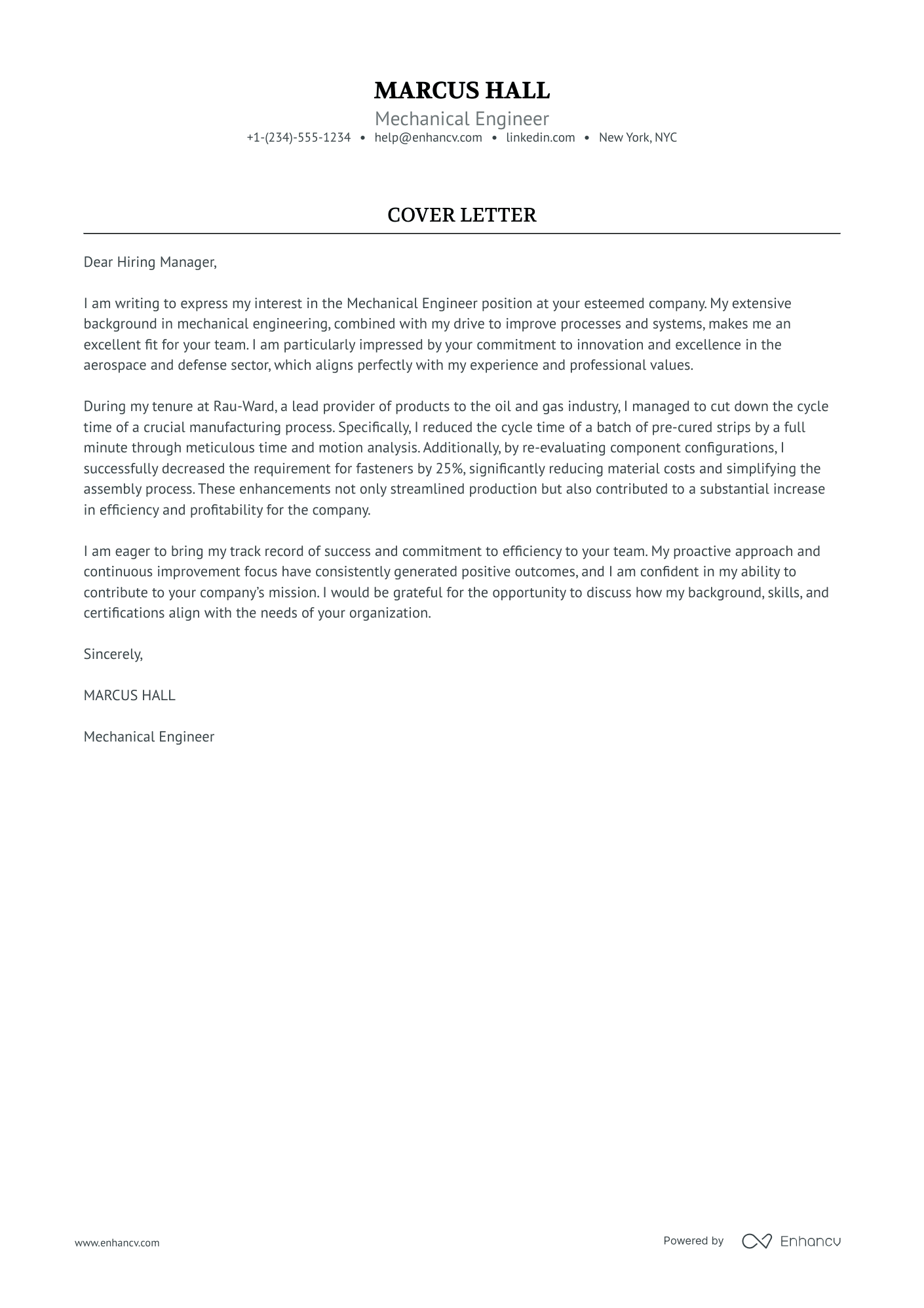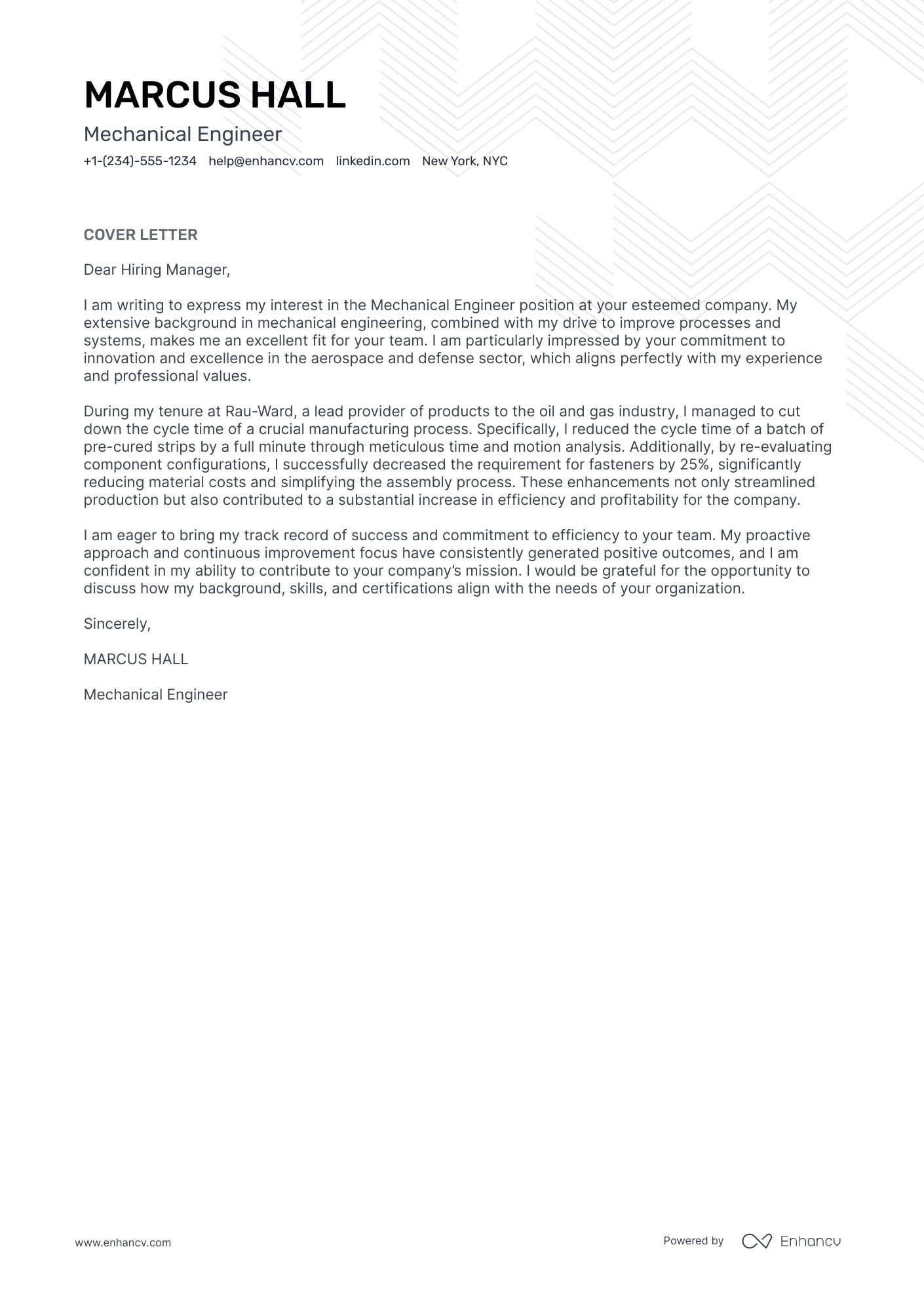Embarking on your job hunt, you've encountered a stumbling block: crafting a compelling design engineer cover letter. Shunning the rehash of your resume, it must spotlight your crowning professional moment, weaving the narrative of your triumph. Keep the formality but ditch the worn-out phrases, crafting a letter that's succinctly limited to a single page. Let's tackle these challenges and help you stand out in a pile of applicants.
- Introduce your profile to catch recruiters' attention;
- Use professional templates and examples to make sure your design engineer cover letter follows the best industry standards;
- Settle on your most story-worthy achievement to shine a light on what makes your application unique;
- Write a design engineer cover letter, even when you lack professional experience.
Ready to start with the basics: upload your resume to Enhancv's AI, below, to see the design engineer cover letter it would write for you.
If the design engineer isn't exactly the one you're looking for we have a plethora of cover letter examples for jobs like this one:
- Design Engineer resume guide and example
- Biomedical Engineer cover letter example
- Project Engineer cover letter example
- Construction Worker cover letter example
- Electrical Engineering cover letter example
- Engineering Intern cover letter example
- Audio Engineer cover letter example
- Electrical Manager cover letter example
- Senior Engineer cover letter example
- Landscape Architect cover letter example
- Product Engineer cover letter example
Drop your resume here or choose a file.
PDF & DOCX only. Max 2MB file size.
Design engineer cover letter example
MARCUS HALL
New York, NYC
+1-(234)-555-1234
help@enhancv.com
Designing your design engineer cover letter: what is the best format
Let's start with the basics, your design engineer cover letter should include your:
- Header
- Greeting
- Introduction
- Body paragraph
- Closing statement
- Signature (that's not a must)
Next, we'll move to the spacing of your design engineer cover letter, and yes, it should be single-spaced (automatically formatted for you in our cover letter templates).
Don't go for a old-school font (e.g. Arial or Times New Roman), but instead, pick an ATS-favorite like Chivo, Volkhov, or Raleway, to stand out.
Our cover letter builder is also set up for you with the standard one-inch margin, all around the text.
Finally, ensure your design engineer resume and cover letter are in the same font and are submitted in PDF (to keep the formatting in place).
P.S. The Applicant Tracker System (or ATS) won't be assessing your [job] cover letter, it's solely for the recruiters' eyes.
Tight on time? Our free cover letter generator helps you create a cover letter instantly from your resume.
The top sections on a design engineer cover letter
- Header: Includes the applicant's contact information, the date, and the recipient’s address, providing the necessary details for the recruiter to respond and creating a professional first impression tailored to the design engineering industry.
- Opening Greeting: Addresses the hiring manager or recruiter directly, using their name if known, which is essential for personalizing the cover letter and establishing a connection within the technical field.
- Introduction: Briefly states the applicant's interest in the design engineer role and mentions how they discovered the job opening, setting the stage for the cover letter and showing genuine enthusiasm for the position.
- Body Paragraphs: Outline relevant engineering projects, technical skills, design accomplishments, and the applicant’s problem-solving abilities, demonstrating their suitability for the design engineer position through specific examples.
- Closing Section: Reaffirms the candidate's interest in the role, suggests the next steps or availability for an interview, and thanks the recipient for considering the application, leaving a courteous and professional final impression.
Key qualities recruiters search for in a candidate’s cover letter
Proficiency in CAD software (e.g., SolidWorks, AutoCAD): Demonstrates the technical skills required to create detailed designs and blueprints, which are crucial in product development and manufacturing processes.
Strong understanding of engineering principles and material properties: Ensures the design engineer can develop functional and reliable products while considering cost-effectiveness and material constraints.
Experience with product lifecycle management (PLM): Indicates familiarity with the stages of product development, allowing for better planning, analysis, and execution of design tasks.
Proven problem-solving skills: Emphasizes the ability to identify design challenges and come up with creative and practical solutions, a core component of engineering challenges.
Effective communication and teamwork: Design engineers often collaborate with cross-functional teams, including manufacturing, marketing, and supply chain; therefore, the ability to communicate clearly and work well within a team is fundamental.
Experience with industry-specific standards and regulations: Understanding of relevant codes and standards ensures that designs comply with legal requirements, safety guidelines, and industry best practices.
Personalizing your design engineer cover letter salutation
Always aim to address the recruiter from the get-go of your design engineer cover letter.
Use:
- the friendly tone (e.g. "Dear Paul" or "Dear Caroline") - if you've previously chatted up with them on social media and are on a first-name basis;
- the formal tone (e.g. "Dear Ms. Gibbs" or "Dear Ms. Swift") - if you haven't had any previous conversation with them and have discovered the name of the recruiter on LinkedIn or the company website;
- the polite tone (e.g. "Dear Hiring Manager" or "Dear HR Team") - at all costs aim to avoid the "To whom it may concern" or "Dear Sir/Madam", as both greetings are very old-school and vague.
List of salutations you can use
- Dear Hiring Manager,
- Dear [Company Name] Team,
- Dear [Department] Team,
- Dear Ms. [Last Name],
- Dear Mr. [Last Name],
- Dear Dr. [Last Name],
The design engineer cover letter introduction: focusing on your unique value, with a creative twist
You are not the only one wondering how to start your design engineer cover letter. Those first two sentences introduce your profile and should be memorable.
No pressure.
When beginning your design engineer cover letter, immediately point out the unique value of working with you. In other words, what you promise to bring to the role by using your past track record of success.
Start your design engineer cover letter with a creative twist by telling a joke or stating something relatable. Select this type of introduction only if it aligns with the company culture.
Choosing your best achievement for the middle or body of your design engineer cover letter
Now that you have the recruiters' attention, it's time to write the chunkiest bit of your design engineer cover letter.
The body consists of three to six paragraphs that focus on one of your achievements.
Use your past success to tell a story of how you obtained your most job-crucial skills and know-how (make sure to back these up with tangible metrics).
Another excellent idea for your design engineer cover letter's middle paragraphs is to shine a light on your unique professional value.
Write consistently and make sure to present information that is relevant to the role.
Final words: writing your design engineer cover letter closing paragraph
The final paragraph of your design engineer cover letter allows you that one final chance to make a great first impression.
Instead of going straight to the "sincerely yours" ending, you can back up your skills with a promise of:
- how you see yourself growing into the role;
- the unique skills you'd bring to the organization.
Whatever you choose, always be specific (and remember to uphold your promise, once you land the role).
If this option doesn't seem that appealing to you, close off your design engineer cover letter with a follow-up request.
You could even provide your availability for interviews so that the recruiters would be able to easily arrange your first meeting.
Design engineer cover letter advice for candidates with no experience
If you're worried about writing your Design Engineer cover letter and have no professional experience, we sure have some advice for you.
Turn recruiters' attention to your transferable or relevant skills gained thanks to your life and work experience.
Instead of writing about past jobs, focus on one achievement (whether from your volunteering experience, education, etc.) and the skills it has helped you build.
Alternatively, you could focus your Design Engineer cover letter on your career objectives and goals. Always remember to make those relevant to the job you're applying for by detailing how you see yourself growing as part of the company.
Recruiters would be way more impressed with candidates who fit the job profile and can bring about plenty of skills and vision to the table.
Key takeaways
Writing your design engineer cover letter doesn't need to turn into an endless quest, but instead:
- Create an individual design engineer cover letter for each role you apply to, based on job criteria (use our builder to transform your resume into a cover letter, which you could edit to match the job);
- Stick with the same font you've used in your resume (e.g. Raleway) and ensure your design engineer cover letter is single-spaced and has a one-inch margin all around;
- Introduce your enthusiasm for the role or the company at the beginning of your design engineer cover letter to make a good first impression;
- Align what matters most to the company by selecting just one achievement from your experience, that has taught you valuable skills and knowledge for the job;
- End your design engineer cover letter like any good story - with a promise for greatness or follow-up for an interview.
Design Engineer cover letter examples
By Role



















